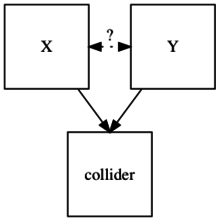Collider (statistics)
In statistics, a variable is termed a collider when it is the outcome of two (or more) variables (that may or may not themselves be correlated) (See Figure 1). The name "collider" reflects the fact that in graphical models, the arrow heads from variables that lead into the collider appear to "collide" on the node that is the collider[1]

The result of having a collider in the path is that the collider blocks[2][3][4] the association between the variables that influence it. Thus, the collider does not generate an unconditional association between the variables that determine it.
Introducing information about the collider via e.g. statistical control, stratification, or sample selection based on values of the collider will open the path and create a non-causal association between X and Y (Berkson's paradox).
Colliders can undermine attempts to test causal theories: By "controlling" for what they consider to be confounding, researchers can unwittingly induce false correlations among the variables of interest.
See also
References
- ^ Hernan, Miguel A; Robins, James M (2010), Causal inference, Chapman & Hall/CRC monographs on statistics & applied probability, CRC, p. 70, ISBN 1-4200-7616-7
- ^ Greenland, Sander; Pearl, Judea; Robins, James M (January 1999), "Causal Diagrams for Epidemiologic Research" (PDF), Epidemiology, 10 (1): 37–48, doi:10.1097/00001648-199901000-00008, ISSN 1044-3983, OCLC 484244020
- ^ Pearl, Judea (1986). "Fusion, Propagation and Structuring in Belief Networks". Artificial Intelligence. 29 (3): 241–288. doi:10.1016/0004-3702(86)90072-x.
- ^ Pearl, Judea (1988). Probabilistic reasoning in intelligent systems: networks of plausible inference. Morgan Kaufmann.
